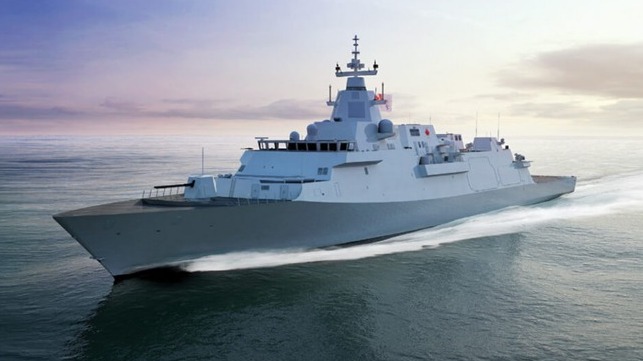Canada Invests in Shipbuilding Preparing for Surface Combatant Construction

The Government of Canada announced it will invest C$463 million (US$345 million) into the shipbuilding infrastructure as it seeks to advance the delayed Surface Combatant (CSC) program which calls for the construction of 15 new warships which will be a key component of the future Royal Canadian Navy. The monies will be used for the Irving Shipyard and related facilities in Nova Scotia in preparation for construction which is now expected to get underway for the program next year.
As part of its National Shipbuilding Strategy, Canada announced the surface combatant program in June 2016 and launched its requests for proposals using a streamlined procurement approach focusing on selecting and customizing an existing warship design. Pre-qualified companies were invited to submit proposals in October 2016 with the goal of selecting the design by the summer of 2017.
The winning bid finalized in February 2019 was based on the BAE Systems Type 26 Global Combatant Ship, with Canada selecting Lockheed Martin Canada for the design of the 15 new warships. With an expected budget of between C$56 to $60 billion, the program called for finalizing the design and starting construction at Irving’s Halifax Shipyard in the early 2020s. Irving Shipbuilding was awarded an initial contract valued at C$185 million for its involvement in the design and preparation for construction.
The program has had to overcome a series of challenges. Alion Science and Technology, one of the failed bidders, sought to challenge the contract in federal court. Canada's parliamentary budget expert in 2021 reported the program was running at nearly three times originally anticipated costs, forecasting a US$62 billion (C$83 billion are 2023 exchange rates) price tag and raising the possibility of truncating the program.
Four years later, the program is still listed as being in the design phase with the government noting that the project is one of the largest, most complex shipbuilding initiatives undertaken by Canada since World War II. In Tuesday’s announcement, they said they were amending the definition contract and investing in the shipbuilding infrastructure to “enhance and accelerate CSC construction.”
Specifically, the monies will be used for enhancements to expand and modify Irving’s Halifax Shipyard and supporting facilities at Woodside Industries and Marine Fabricators in Dartmouth, Nova Scotia. According to the announcement, the enhancements were identified during the design phase and from lessons learned during the construction of ships in the United Kingdom and Australia, which are also based on the same Type 26 model as the CSC.
"This key announcement reaffirms Canada's commitment to deliver 15 state-of-the-art warships to the Royal Canadian Navy, and to provide Canadian Armed Forces members with the equipment needed to defend Canada,” said Canada’s Minister of National Defence, Bill Blair. “This investment will expand shipbuilding and support facilities on our East Coast – boosting and accelerating the capacity of our industry partners to deliver new ships to our navy."
The base design calls for ships that would be approximately 492 feet in length and 6,900 tonnes displacement. The ships use a gas turbine direct drive with two electric motors and four high-speed diesel generators to produce a top speed in excess of 26 knots. The ships are designed with a range of over 7,000 nautical miles in Electric-Motor drive and accommodations for a total of 208 crew and a core complement of 157 sailors and officers. The design calls for a medium-caliber gun and anti-air missiles.
The start of construction activities on the CSC vessels is now anticipated to begin in 2024, with full-rate production to begin under the implementation contract in 2025. Ship delivery is expected to begin in the early 2030s and be completed by 2050. The new warships would be used to replace both the Halifax-class frigates and retire Iroquois-class destroyers.
Deployed, the Canadian government has said the mission for the new vessels would range from counter-piracy, counter-terrorism, interdiction, and embargo operations, and to support land operations. In addition to sovereignty enforcement, the vessels will be able to undertake humanitarian aid and search and rescue missions.
